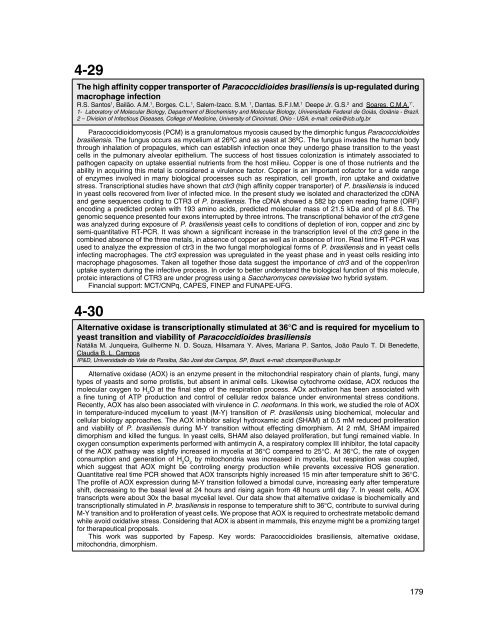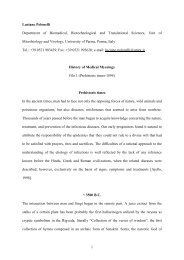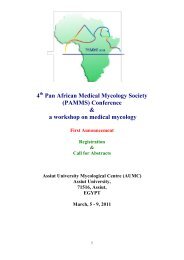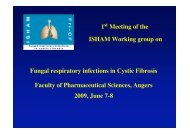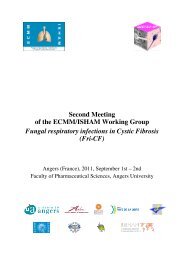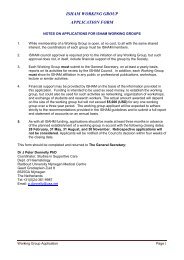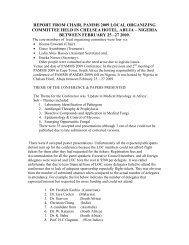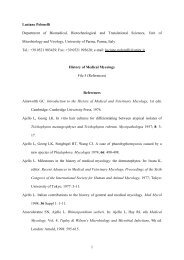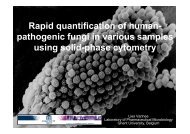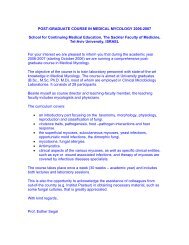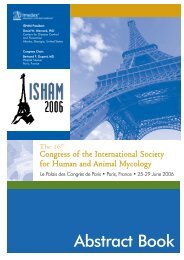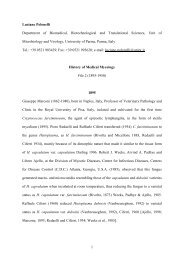Memoria CD.indd - ISHAM
Memoria CD.indd - ISHAM
Memoria CD.indd - ISHAM
You also want an ePaper? Increase the reach of your titles
YUMPU automatically turns print PDFs into web optimized ePapers that Google loves.
4-29The high affinity copper transporter of Paracoccidioides brasiliensis is up-regulated duringmacrophage infectionR.S. Santos 1 , Bailão. A.M. 1 , Borges. C.L. 1 , Salem-Izacc. S.M. 1 , Dantas. S.F.I.M. 1 , Deepe Jr. G.S.2 and Soares. C.M.A. 1* .1- Laboratory of Molecular Biology, Department of Biochemistry and Molecular Biology, Universidade Federal de Goiás, Goiânia - Brazil.2 – Division of Infectious Diseases, College of Medicine, University of Cincinnati, Ohio - USA. e-mail: celia@icb.ufg.brParacoccidioidomycosis (PCM) is a granulomatous mycosis caused by the dimorphic fungus Paracoccidioidesbrasiliensis. The fungus occurs as mycelium at 26ºC and as yeast at 36ºC. The fungus invades the human bodythrough inhalation of propagules, which can establish infection once they undergo phase transition to the yeastcells in the pulmonary alveolar epithelium. The success of host tissues colonization is intimately associated topathogen capacity on uptake essential nutrients from the host milieu. Copper is one of those nutrients and theability in acquiring this metal is considered a virulence factor. Copper is an important cofactor for a wide rangeof enzymes involved in many biological processes such as respiration, cell growth, iron uptake and oxidativestress. Transcriptional studies have shown that ctr3 (high affinity copper transporter) of P. brasiliensis is inducedin yeast cells recovered from liver of infected mice. In the present study we isolated and characterized the cDNAand gene sequences coding to CTR3 of P. brasiliensis. The cDNA showed a 582 bp open reading frame (ORF)encoding a predicted protein with 193 amino acids, predicted molecular mass of 21.5 kDa and of pI 8.6. Thegenomic sequence presented four exons interrupted by three introns. The transcriptional behavior of the ctr3 genewas analyzed during exposure of P. brasiliensis yeast cells to conditions of depletion of iron, copper and zinc bysemi-quantitative RT-PCR. It was shown a significant increase in the transcription level of the ctr3 gene in thecombined absence of the three metals, in absence of copper as well as in absence of iron. Real time RT-PCR wasused to analyze the expression of ctr3 in the two fungal morphological forms of P. brasiliensis and in yeast cellsinfecting macrophages. The ctr3 expression was upregulated in the yeast phase and in yeast cells residing intomacrophage phagosomes. Taken all together those data suggest the importance of ctr3 and of the copper/ironuptake system during the infective process. In order to better understand the biological function of this molecule,proteic interactions of CTR3 are under progress using a Saccharomyces cerevisiae two hybrid system.Financial support: MCT/CNPq, CAPES, FINEP and FUNAPE-UFG.4-30Alternative oxidase is transcriptionally stimulated at 36°C and is required for mycelium toyeast transition and viability of Paracoccidioides brasiliensisNatália M. Junqueira, Guilherme N. D. Souza, Hilsamara Y. Alves, Mariana P. Santos, João Paulo T. Di Benedette,Claudia B. L. CamposIP&D, Universidade do Vale do Paraiba, São José dos Campos, SP, Brazil. e-mail: cbcampos@univap.brAlternative oxidase (AOX) is an enzyme present in the mitochondrial respiratory chain of plants, fungi, manytypes of yeasts and some protistis, but absent in animal cells. Likewise cytochrome oxidase, AOX reduces themolecular oxygen to H 2O at the final step of the respiration process. AOx activation has been associated witha fine tuning of ATP production and control of cellular redox balance under environmental stress conditions.Recently, AOX has also been associated with virulence in C. neoformans. In this work, we studied the role of AOXin temperature-induced mycelium to yeast (M-Y) transition of P. brasiliensis using biochemical, molecular andcellular biology approaches. The AOX inhibitor salicyl hydroxamic acid (SHAM) at 0.5 mM reduced proliferationand viability of P. brasiliensis during M-Y transition without effecting dimorphism. At 2 mM, SHAM impaireddimorphism and killed the fungus. In yeast cells, SHAM also delayed proliferation, but fungi remained viable. Inoxygen consumption experiments performed with antimycin A, a respiratory complex III inhibitor, the total capacityof the AOX pathway was slightly increased in mycelia at 36°C compared to 25°C. At 36°C, the rate of oxygenconsumption and generation of H 2O 2by mitochondria was increased in mycelia, but respiration was coupled,which suggest that AOX might be controling energy production while prevents excessive ROS generation.Quantitative real time PCR showed that AOX transcripts highly increased 15 min after temperature shift to 36°C.The profile of AOX expression during M-Y transition followed a bimodal curve, increasing early after temperatureshift, decreasing to the basal level at 24 hours and rising again from 48 hours until day 7. In yeast cells, AOXtranscripts were about 30x the basal mycelial level. Our data show that alternative oxidase is biochemically andtranscriptionally stimulated in P. brasiliensis in response to temperature shift to 36°C, contribute to survival duringM-Y transition and to proliferation of yeast cells. We propose that AOX is required to orchestrate metabolic demandwhile avoid oxidative stress. Considering that AOX is absent in mammals, this enzyme might be a promizing targetfor therapeutical proposals.This work was supported by Fapesp. Key words: Paracoccidioides brasiliensis, alternative oxidase,mitochondria, dimorphism.179


